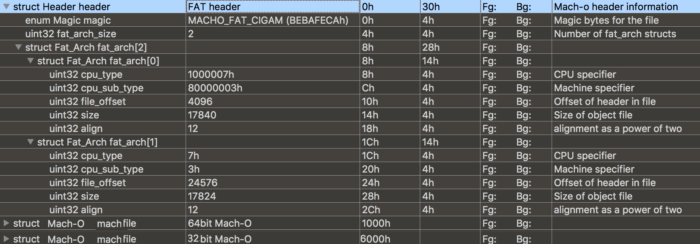This is part two on our series on Mach-O executables, where in the first part we did a deep dive on the Mach-O file format. During the Apple-Intel transition, when they were moving from PowerPC to Intel x86_64 architecture, Apple came out with the Mach-O Universal Executable, a play on existing Fat binaries. This is one of the more interesting binaries types I’ve ever encountered. The Fat / Universal binary format acts as a wrapper for multiple Mach-O binaries of different architectures and CPU types. Meaning these binaries can run on multiple different architecture CPUs. Already having the ability to parse and write the Mach-O file structures, parsing the additional Fat headers is actually pretty simple. We’ve added both parsing and writing support for this file in our binject/debug library. Originally this was to include functionality for such 3rd party signing attacks as described in this set of posts. But legacy file types often contain many exploitable properties, and this file type may even be coming back as Apple is rumored to be moving to ARM CPUs from the Intel CPUs in the future, so let’s dig into the file format and learn some more.
Universal Binary Overview
A high level overview of a Fat / Universal Mach-O file is actually pretty simple, as the Fat headers simply act as a wrapper for the multiple Mach-O files contained within. While these can hold any number of Mach-O files within, on MacOS they are often found with two, being used to bridge between CPU transitions. Below we dive into what these Fat headers actually contain, but short to say it’s not too much. Here is an example of a Fat file structure that contains two Mach-O structures within one Universal file:

Universal Header
The Fat Mach-O file header starts with some special magic bytes, then moves on to a 4 byte arch size variable; the arch size is the length of the next dynamically sized section, the arch headers array, with one descriptor for each Mach-O structure contained within the Fat binary. Each arch header contains the same 5 properties, each 4 bytes in length. Each arch header contains the cpu and subcpu fields, which specify the architecture and cpu type the corresponding Mach-O file is for. When a Universal binary is loaded into memory this is what is checked to see what Mach-O file contained within should be loaded. Following that is the arch offset, arch size, and arch alignment, all of which specify where the corresponding Mach-O structure is located and how large it is.
N Mach-O Structures
Following the Fat binary header, there is a Mach-O structure for each of the corresponding arch headers. Each Mach-O file starts at it’s specified offset with large pads of 0 bytes between the headers and each respective Mach-O file. The Mach-O files themselves follow the exact structure outlined in the first post on Mach-Os, except for a slight difference between the reserved bytes (the i386 arch Mach-O binaries don’t seem to have the four reserved 0-bytes after the header). Simply put, these are normal Mach-O files.
Conclusion
This is an interesting file format that is still around on modern MacOS versions, and may even be coming back if Apple makes the move from Intel CPUs to ARM CPUs in the future. Ultimately, this is a pretty simple file format, but I think there is a lot of room for abuse here which we plan to experiment with in our Binjection library! Stop by soon for more interesting low level file format posts!
